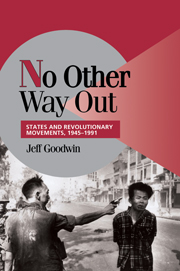Book contents
- Frontmatter
- Contents
- Figures, Tables, and Maps
- Abbreviations and Acronyms
- Preface and Acknowledgments
- Part 1 Introduction
- Part 2 Southeast Asia
- Part 3 Central America
- Part 4 Further Comparisons and Theoretical Elaborations
- 7 BETWEEN SUCCESS AND FAILURE: PERSISTENT INSURGENCIES
- CHRONOLOGY FOR EASTERN EUROPE
- 8 “REFOLUTION” AND REBELLION IN EASTERN EUROPE, 1989
- 9 CONCLUSION: GENERALIZATIONS AND PROGNOSTICATION
- Annotated Bibliography
- Index
- Titles in the series
7 - BETWEEN SUCCESS AND FAILURE: PERSISTENT INSURGENCIES
Published online by Cambridge University Press: 05 June 2012
- Frontmatter
- Contents
- Figures, Tables, and Maps
- Abbreviations and Acronyms
- Preface and Acknowledgments
- Part 1 Introduction
- Part 2 Southeast Asia
- Part 3 Central America
- Part 4 Further Comparisons and Theoretical Elaborations
- 7 BETWEEN SUCCESS AND FAILURE: PERSISTENT INSURGENCIES
- CHRONOLOGY FOR EASTERN EUROPE
- 8 “REFOLUTION” AND REBELLION IN EASTERN EUROPE, 1989
- 9 CONCLUSION: GENERALIZATIONS AND PROGNOSTICATION
- Annotated Bibliography
- Index
- Titles in the series
Summary
It was that massacre, the most horrible, that really caused the glass of water to overflow. … People flowed out of the zone, either toward Honduras or south … or into the guerrillas. A lot of people joined us as combatants then.
– “Licho,” a Salvadoran guerrilla, on the El Mozote massacre of December 1981 (quoted in Danner 1993: 101)The previous chapter characterized the Salvadoran and Guatemalan revolutionary movements as failures, which is true by definition if a revolution, or a “successful” revolution, requires the overthrow of the existing state. But there is another side to the proverbial coin: As we have seen, the Salvadoran and Guatemalan states were themselves unable to defeat militarily the revolutionary movements that challenged them. This raises a question that has received relatively little attention in the literature on revolutionary movements (and social movements more generally): Why have certain movements (but not others) been able to persist for many years or even decades, maintaining a significant base of popular support, even when subjected to extraordinary levels of state violence? To address this question, I compare in this chapter cases of “persistent insurgency” in El Salvador, Guatemala, and Peru (with a glance at Colombia) with major defeated rebellions in Malaya and the Philippines (discussed in Part 2) as well as Venezuela.
- Type
- Chapter
- Information
- No Other Way OutStates and Revolutionary Movements, 1945–1991, pp. 217 - 253Publisher: Cambridge University PressPrint publication year: 2001



